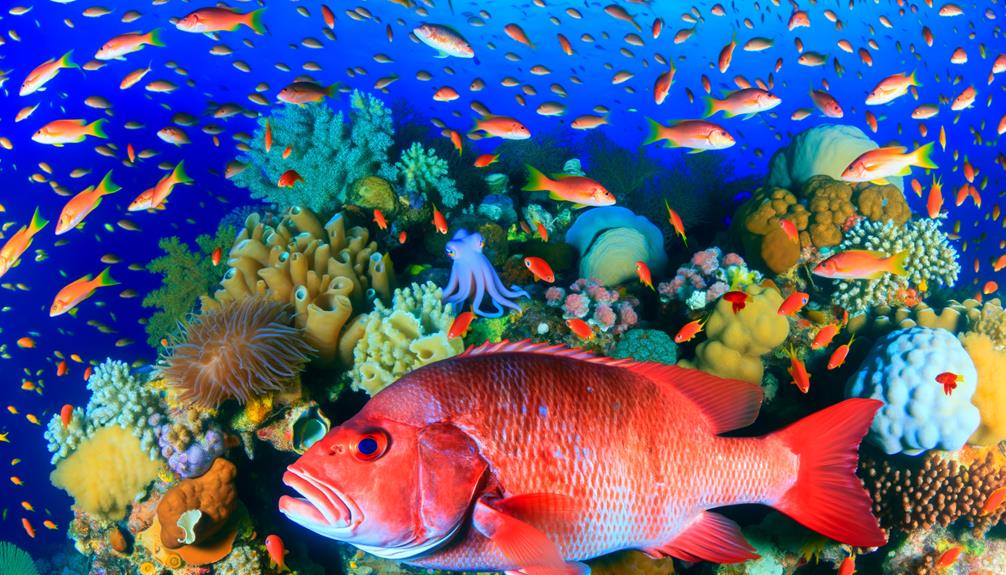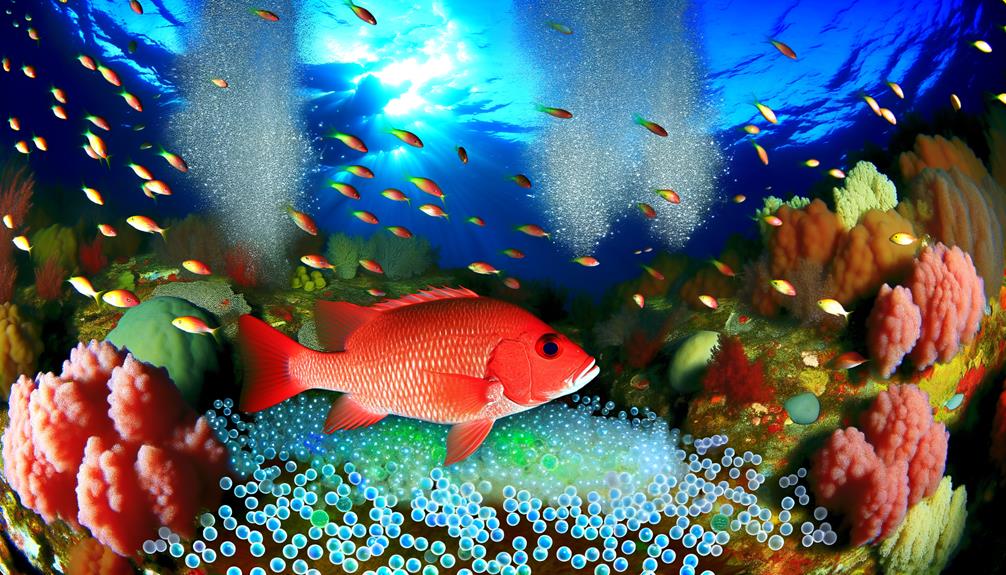The Red Snapper, Lutjanus campechanus, is a vibrant, brick-red fish known for its residence in saltwater regions, particularly the Southern Atlantic and the Gulf of Mexico. Its preference for habitats around drilling platforms, deep banks, and artificial reefs make it a fascinating subject for discussion.
What interesting characteristics allow it to thrive in such environments, and how do these habitats impact its behavior, diet, and reproduction? Moreover, why are certain conservation efforts vital to preserving the Red Snapper's saltwater existence?
These are questions that we shall explore, stimulating further curiosity about this unique saltwater dweller.
Key Takeaways
- Red Snapper is indeed a saltwater fish, primarily inhabiting the Gulf of Mexico and western Atlantic.
- The survival, development, and reproductive behavior of Red Snapper are heavily influenced by saltwater environments.
- Specific environmental factors like temperature and salinity in the saltwater habitats shape the Red Snapper's diet and habitat preferences.
- Saltwater habitats, particularly those with rocky bottoms, ledges, and artificial structures, provide crucial cover, hunting grounds, and optimal conditions for Red Snapper.
Understanding Red Snapper's Habitat
The habitat of the Red Snapper, a saltwater fish predominantly dwelling in the Gulf of Mexico and western Atlantic, is a fascinating study in marine ecology, with the young preferring shallow waters and adults favoring the deeper maritime expanses near shipwrecks and rocky terrain.
This reef fish displays a distinct spatial segregation by age, with juveniles favoring the relative safety of the shallows and adults venturing into the deeper, harsher environments. This habitat preference is further influenced by the topography of the seafloor. Snappers are drawn to areas of rough, rocky terrain, which provide both shelter from predators and abundant food resources.
Interestingly, despite their wide distribution, Red Snappers are rarely found north of the Carolinas in the US and are notably absent in the Caribbean compared to their southern range. This geographical distribution suggests that specific environmental factors, such as temperature and salinity, likely play a role in shaping their habitat preferences.
Through this understanding of their habitat, we can draw a clearer picture of the complex interactions between the Red Snapper and its environment, offering insights into the life history of this remarkable saltwater fish and its role within the broader marine ecosystem.
Red Snapper's Saltwater Survival
Building on the understanding of Red Snapper's habitat preferences, it's crucial to examine how these saltwater environments, with depths ranging from 30 to 620 feet, provide the necessary conditions for the species' survival, growth, and reproduction. The Red, or more specifically, northern red snappers, are highly adaptable to these conditions, making them a prominent figure in saltwater fishing.
To further elucidate this, we can highlight key factors that contribute to the survival of red snappers in saltwater habitats:
- The water's salinity and temperature range is conducive to the development and survival of red snappers.
- These habitats, often featuring rocky bottoms and ledges, provide ample cover and hunting grounds.
- Artificial structures like offshore oil rigs act as accidental reefs, attracting a variety of marine life, including red snappers.
- Saltwater environments support a rich food chain that sustains red snappers.
- Their superior adaptability allows them to thrive in varying saltwater depths, from shallow coastal areas to deep sea regions.
In essence, the unique characteristics of saltwater environments, coupled with the adaptability of the Red Snapper, create a symbiotic relationship that ensures the survival and growth of this beloved species.
The Diet of Saltwater Red Snapper

Delving into the dietary habits of the saltwater Red Snapper reveals a remarkable adaptability to their marine environment, primarily sustained by a diet of smaller fish, worms, and crustaceans. Their nutritional intake is characterized by a diverse assortment of prey items, including shrimp, squid, and small baitfish, showcasing their opportunistic feeding behavior.
Predatory instincts underlie the consumption patterns of Red Snapper, with their hunting activities focused on slow-moving prey along the ocean floor. Their bright coloring serves as an effective tool in these endeavors, enabling them to spot and catch prey effectively within their aquatic surroundings.
Their dietary preferences are largely dictated by the availability of food sources in their immediate environment. This adaptability underscores the Red Snapper's survival strategy, with their dietary flexibility acting as a significant factor in their ability to thrive in their saltwater habitat.
Saltwater Fishing for Red Snapper
Having examined the dietary habits of the Red Snapper, it is imperative to explore another significant aspect of their existence, specifically their role as a target species in saltwater fishing. The Gulf of Mexico, in particular, is a popular location for red snapper fishing due to the fish's preference for rocky bottoms, shipwrecks, and deep offshore reefs.
Anglers often employ bottom fishing techniques, using squid or fish bait to attract the snapper. The vibrant pink/red coloration of the snapper also aids in their identification within these saltwater environments.
Notably, red snapper exhibit an interesting behavior pattern:
- They are anadromous, migrating to deeper waters as they mature.
- This migration pattern makes them a challenging, yet rewarding catch for seasoned anglers.
- They are often found near structures like oil rigs, which they use for protection.
- Their preference for complex habitats makes them an exciting species for divers and underwater photographers.
- Their striking coloration and size make them a prized catch among saltwater fish, contributing to their popularity in the sport fishing community.
Importance of Saltwater for Red Snapper's Reproduction

The intricate relationship between the Red Snapper and its saltwater habitat becomes particularly evident when examining the fish's reproductive processes, which are intricately tied to the specific conditions found in these marine environments. Red Snapper, indigenous to the Atlantic, displays a spawning behavior heavily reliant on their saltwater environment. These marine habitats offer optimal conditions for the release and development of red snapper eggs.
The saltwater environment plays an indispensable role in the early life stages of red snapper. The eggs, once released, float in the ocean currents, nurtured by the saltwater resources. The salinity, temperature, and nutrient availability in these habitats contribute to the successful development and survival of the larvae, ultimately determining the health and size of red snapper populations.
In essence, the connection between saltwater and red snapper reproduction is not just a matter of preference but an ecological necessity. The availability of saltwater resources, combined with specific environmental conditions, directly influences the spawning behavior, egg development, and subsequent survival chances of red snapper. Thus, the future of this species is inexorably linked to the preservation of their saltwater habitats.
Frequently Asked Questions
Is Red Snapper Saltwater or Freshwater?
Red Snapper, known for its adaptability, thrives in saltwater habitats, preferring depths between 30-620 feet. Its diet, reproduction, and survival from predators are all influenced by the unique conditions of these marine ecosystems.
Is There Such Thing as a Freshwater Snapper?
No freshwater snapper exists as snapper species, including Red Snapper, are adapted to marine habitats. Their diet, breeding, and fishing practices are all associated with saltwater environments, affirming their exclusive presence in oceanic ecosystems.
Is Red Snapper a Cold Water Fish?
Red Snapper, preferring warm tropical waters, is not a cold-water fish. Their habitat in the Gulf of Mexico provides ideal conditions for their diet, reproduction, and long lifespan, making them a popular target for fishing.
Is Red Snapper a Reef Fish?
Yes, Red Snapper is indeed a reef fish. It exhibits a rich species diversity, unique feeding habits, and specific breeding patterns. Its lifespan and conservation efforts significantly contribute to maintaining the balance in reef ecosystems.
Conclusion
In a paradoxical twist, the thriving existence of Red Snapper, a renowned saltwater species, is contingent on human-driven platforms and artificial reefs. This dynamic underscores the critical importance of sustainable fishing practices and stringent regulations in preserving this species.
Ultimately, the survival of the saltwater Red Snapper not only enhances the marine ecosystem but also perpetuates the cherished tradition of recreational and commercial fishing.


